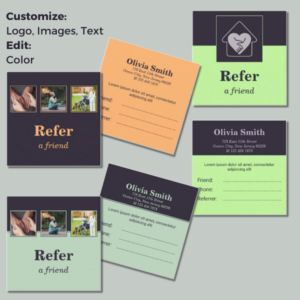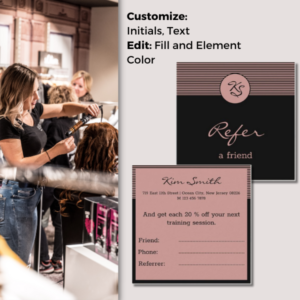Refer a Friend cards are a classic, yet effective way to leverage your existing customer base. However, in the age of digital marketing and social media, offline marketing strategies often take a back seat. There’s still a lot of value in traditional methods, especially when it comes to word-of-mouth referrals.
In this article, we’ll explore the enduring power of these physical cards and why they remain a valuable tool in a marketer’s arsenal.

What you will find in this article:
- The Tangible Touch, Physical Referral Cards
- How to Create a “Refer a Friend” Card That Works
- What Are the Best Dimensions for Referral Cards?
- Refer a Friend Card Designs by KBMD3signs on the Zazzle
- How to Track and Measure Referral Cards for Its Effects
- What Businesses Are Best Suited for Refer a Friend Programs?
- FAQ’s about Offline Refer a Friend Cards
1. The Tangible Touch, Physical Referral Cards
One of the primary advantages of handed-out “Refer a Friend” cards is their tangible nature. In an increasingly digital world, receiving a physical card can make a lasting impression on your customers. These cards serve as a physical reminder of your brand, making it more likely that they will follow through with the referral. The act of handing out a card also establishes a personal connection, which can be particularly impactful when trying to encourage a friend to become a customer.
Customization and Branding
Refer a Friend cards offer a unique opportunity for customization and branding. You have complete control over the design, ensuring that it aligns with your brand’s identity and message. These cards can be made visually appealing, making them more likely to be kept by your customers. The ability to customize allows you to create a memorable, shareable piece of marketing collateral that stands out in your customer’s wallet or on their fridge.
Simplicity and Convenience
The simplicity of “Refer a Friend” cards is a significant advantage. They don’t require any special equipment, software, or technical knowledge. You can easily design and print them, making it a cost-effective option for businesses of all sizes. Plus, they are incredibly convenient for both your existing customers and potential new ones. There’s no need for your customers to remember a referral link or code – they have the card right in front of them. Similarly, their friends can conveniently contact your business when ready.
Encouraging Word-of-Mouth Marketing
Word-of-mouth marketing is one of the most powerful tools in a business’s marketing arsenal. Offline “Refer a Friend” cards leverage the influence of your satisfied customers. When they personally hand a card to a friend, it carries their endorsement, building trust and increasing the likelihood of conversion. Moreover, the personal touch of a card often leads to conversations about your business between friends, further spreading the word.
Tracking and Measuring Results
Measuring the effectiveness of your marketing efforts is crucial, and offline “Refer a Friend” cards can be a more straightforward method than digital referrals. By tracking the number of cards redeemed or referrals generated through these cards, you can gauge the success of your campaign. You can also make changes and improvements to your strategy based on the data you collect.
Bottom Line
While digital marketing is undoubtedly a vital component of any modern business strategy, it’s important not to overlook the benefits of offline marketing techniques such as refer-a-friend cards. These tangible, customizable, and convenient tools can effectively harness the power of word-of-mouth to help you grow your customer base and increase brand loyalty. By incorporating these offline cards into your marketing efforts, you can strike a balance between traditional and digital methods for optimal results. So don’t underestimate the enduring power of offline refer-a-friend cards; they could be just the boost your business needs.
2. How to Create a “Refer a Friend” Card That Works
“Refer a Friend” cards are an excellent way to encourage word-of-mouth referrals and expand your customer base. To make these cards effective, it’s essential to include the right information and elements that facilitate the referral process. Here’s what you should include on handed-out “Refer a Friend” cards:
2-1. Company Logo and Branding:
Start with your company’s logo and branding elements to make the card instantly recognizable and establish trust.
2-2. Promotion or Offer:
Clearly state the incentive for the referral. Whether it’s a discount, a free product or service, a gift, or some other special offer, it should be prominent and appealing.
2-3. Referral Code or Identifier:
Include a unique referral code or identifier that associates the referral with the customer who handed out the card. This is essential for tracking and rewarding successful referrals.
2-4. Call to Action (CTA):
Use a clear and concise CTA that instructs the recipient on how to claim the referral offer. For example, “Present this card at checkout to receive 20% off” or “Call us and mention this code to get a discount.”
2-5. Expiration Date:
Specify when the offer expires. Limited-time offers create a sense of urgency and encourage swift action.
2-6. Contact Information:
Provide essential contact details for your business, such as a phone number, email address, physical address, and website. This ensures that potential new customers can easily reach out for more information or to redeem the offer.
2-7. Referral Instructions:
Include straightforward instructions on how the referral process works. For instance, “Give this card to a friend, and when they make a purchase, you both get a reward.”
2-8. Terms and Conditions:
If there are any terms and conditions associated with the referral program or offer, include them on the card. This may include restrictions, eligibility criteria, or limitations.
2-9. Social Media Links:
If your business has an active social media presence, consider adding icons or links to your social profiles. This allows the recipient to learn more about your business and stay connected.
2-10. Design and Visual Appeal:
Ensure that the card is visually appealing with a well-designed layout, colors, and graphics. An aesthetically pleasing card is more likely to be retained and shared.
2-11. Space for Personalization:
Leave some space on the card for the referring customer to write their name or add a personalized message to the recipient. This personal touch can enhance the referral process.
2-12. Tracking Information (Optional):
For more advanced systems, you can include tracking information such as a QR code, a barcode, or a unique serial number that simplifies the referral tracking process.
2-13. Legal Disclaimer:
Depending on your business type and location, you may need to include legal disclaimers related to privacy, data usage, or any other relevant regulations.
Remember that the key to successful “Refer a Friend” cards is to make the process as straightforward and attractive as possible for both your existing customers and potential new customers. Clarity, an appealing design, and a valuable offer are essential components of creating effective referral cards.
3. What Are the Best Dimensions for Referral Cards?
There is no one-size-fits-all recommendation for the size of offline “Refer a Friend” cards, as it can vary depending on your specific needs, design, and preferences. However, there are some common sizes for printed marketing materials that you can consider for your referral cards. The most common sizes for marketing materials are:
Standard Business Card Size:
This is a widely recognized and convenient size for referral cards. Standard business cards typically measure 3.5 x 2 inches (88.9 x 50.8 mm). This size is practical because it fits easily in wallets, pockets, and cardholders, making it more likely for your customers to carry and distribute the cards.
Postcard Size:
You can also consider a larger size, such as the standard postcard size, which is typically 4 x 6 inches (101.6 x 152.4 mm). A larger card can allow for more design elements and information, but it may be less likely to be carried in wallets or shared as readily as a smaller card.
Custom Size:
Depending on your design and branding preferences, you can choose a custom size for your referral cards. Just make sure it’s not too large to be impractical or too small to convey the necessary information.
When deciding on the size of your referral cards, consider the following factors:
- Practicality: Choose a size that is practical for your customers to carry in their wallets or purses and hand out to friends.
- Design and Information: Ensure that the size allows you to include all the necessary information and design elements without overcrowding or making the card too small to read.
- Branding and Recognition: Stick to a size that aligns with your branding and makes your cards easily recognizable.
- Cost: Keep in mind that larger cards may be more expensive to print and mail, so balance your budget with your marketing goals.
- Storage and Distribution: Consider how you plan to store and distribute the cards. If you’re going to use a cardholder or display them at your business, make sure the size fits the available space.
To summarize, while there is no strict size recommendation, the standard business card size is a practical and widely accepted choice for offline Refer a Friend cards. However, you can choose a size that best suits your specific needs and design considerations, keeping in mind practicality, branding, and budget.
4. Refer a Friend Card Designs by KBMD3signs on Zazzle
Our commitment to our mission is reflected in our Refer a Friend cards, designed by KBM D3signs. By offering easily customizable templates within our marketing packages, we strive to simplify the customization process. Our belief is rooted in the idea that everyone should have the freedom to choose their preferred colors for a selected design. This ensures that it perfectly matches your vision and needs.
With the Cocoon It! store from KBM D3signs on Zazzle puts all the branding elements and color schemes in your hands. Your brand’s unique identity is yours to define, whether you’re choosing products with a QR code – where the second color is limited to black or white for optimal contrast – or exploring the vast array of customizable elements through the “Edit Further” link.
We use color tools to help you choose the perfect hues, and for additional inspiration, explore our curated collection of color palette ideas. Our commitment to customization goes beyond placeholders-almost all elements can be customized to match your chosen colors.
If you need additional assistance customizing or transferring designs to different products, or if you have a unique vision that requires a custom design, we are just a message away. At Designs by KBM D3signs, we go beyond providing marketing materials; we empower you to shape and showcase your brand with creativity and personalization.
Shop at Zazzle Store
Cocoon It! – Referral Card Templates
Show off your personal style or post a review!
5. How to Track and Measure Referral Cards for Its Effects
Tracking and measuring the success of your offline “Refer a Friend” cards is crucial to understand the effectiveness of your referral program and make improvements where necessary. Here are several suitable methods for tracking and measuring the success of these cards:
Unique Referral Codes or Identifiers:
Assign a unique referral code or identifier to each card. When a referral is made, ensure that both the referrer and the new customer provide this code. This allows you to directly attribute referrals to specific cards and individuals.
Redemption Tracking:
Keep a record of how many cards are redeemed. This data will give you a clear picture of how many referrals have been converted into actual customers.
Customer Surveys:
Include a simple survey on the cards, asking new customers how they heard about your business. If they received the referral card from a friend, this information can be valuable for tracking success.
Manual Data Entry:
Create a system for manually recording the details of each referral when the referred customer makes a purchase. While this method can be labor-intensive, it’s effective for small businesses with a limited number of referrals.
Point-of-Sale (POS) Integration:
If you have a point-of-sale system, integrate it with your referral program. When a referral card is used, it can trigger automatic tracking of the referral, making the process more efficient and accurate.
Customer Feedback:
Encourage your customers to provide feedback or comments when they refer a friend using the card. This feedback can help you understand the effectiveness of the referral program and make improvements based on their suggestions.
Tracking Software:
If your budget allows, invest in referral tracking software that enables you to monitor the entire referral process, from the initial distribution of the cards to the conversion of referrals. These systems often provide comprehensive analytics.
Promo Code Usage:
If the referral cards include promo codes, monitor the usage of these codes in your sales records. This can help you determine which referrals were generated through the cards.
Conversion Rate:
Calculate the conversion rate by dividing the number of new customers acquired through referrals by the total number of referral cards distributed. This metric helps you understand the effectiveness of your program in terms of converting referrals.
Customer Retention and Lifetime Value:
Keep track of the long-term value of referred customers. Are they more likely to become repeat customers, and do they have a higher lifetime value? This can provide insights into the quality of referrals.
Survey Recipients:
Occasionally survey recipients of referral cards to understand whether they received and considered the offer. This information can help you refine your strategy.
Comparative Analysis:
Compare the performance of your referral cards with other marketing channels or strategies to see how it measures up in terms of cost-effectiveness and customer acquisition.
Remember that tracking and measuring the success of offline “Refer a Friend” cards may require a combination of these methods. The most suitable method for your business will depend on its size, budget, and available resources. Regularly analyze the collected data and use it to optimize your referral program for better results.
6. What Businesses Are Best Suited for Refer a Friend Programs?
“Refer a Friend” cards can be a valuable marketing tool for a wide range of businesses and services, especially those that rely on customer referrals, word-of-mouth marketing, and building a loyal customer base. Here are some examples of businesses and services that can profit from using offline referral cards:
Retail Stores:
Both brick-and-mortar like florists and e-commerce retailers can benefit from referral cards to encourage customers to invite their friends to shop and earn discounts or rewards.
Restaurants and Cafes:
Offering referral cards to diners can be an effective way to increase foot traffic and attract new patrons through personal recommendations.
Salons and Spas:
Beauty and wellness businesses can encourage loyal clients to refer friends for services like hair stylists, massages, yoga, or skincare treatments.
Gyms and Fitness Centers:
Fitness businesses can use referral cards to motivate members to bring their workout buddies and expand their customer base.
Healthcare Providers:
Medical, dental practices, and home care services can use referral cards to encourage patients to refer friends and family for check-ups or treatments.
Car Dealerships:
Offering referral cards to existing customers can motivate them to refer friends or family looking for a new car, with rewards for successful referrals.
Financial Institutions:
Banks and credit unions can use referral cards to encourage existing customers to refer new clients for account openings or loans.
Real Estate Agents:
Real estate professionals can provide referral cards to satisfied clients who may refer friends looking to buy or sell a home.
Professional Services:
Businesses offering legal, accounting, financial planner, life coaching or consulting services can use referral cards to expand their client base through personal recommendations.
Home Services:
Companies offering home improvement, landscaping, or pest control services, house cleaning and lawn care services can use referral cards to generate new business through word-of-mouth referrals.
Hospitality and Travel:
Hotels, resorts, and travel agencies can offer referral cards to guests, incentivizing them to refer friends and family for future bookings.
Auto Repair Shops:
Mechanics and auto repair businesses can encourage customers to refer others for their automotive needs, such as repairs or maintenance.
Pet Services:
Pet grooming, boarding, and training facilities can use referral cards to attract new customers through referrals from existing pet owners.
Educational Services:
Tutoring centers, language schools, and test prep services can use referral cards to encourage students to refer peers seeking educational assistance.
Event and Entertainment Businesses:
Event organizers, concert venues, and entertainment providers can benefit from referral cards to increase ticket sales through personal recommendations.
Nonprofit Organizations:
Even nonprofit organizations can use referral cards to encourage their supporters to refer friends and family to donate or volunteer.
Subscription Services:
Businesses offering subscription-based services, such as streaming platforms, magazines, or meal kit deliveries, can use referral cards to increase their subscriber base.
Small Local Businesses:
Local shops, cafes, and services, such as a photographer can leverage referral cards to build a strong community of loyal customers and expand their customer base.
The effectiveness of referral cards may vary depending on the industry and the specific business, but they can be a versatile tool for any business that relies on building a loyal customer base and values word-of-mouth marketing. It’s essential to design your referral program and cards to suit your business model and customer demographics effectively.
-

6 Offline Summer Marketing Ideas for Small Businesses
Read the post …: 6 Offline Summer Marketing Ideas for Small Businesses -

What is Seasonal Marketing? A Guide for Small Business Offline Success
Read the post …: What is Seasonal Marketing? A Guide for Small Business Offline Success -

Mother’s Day Marketing Ideas for Small Local Businesses
Read the post …: Mother’s Day Marketing Ideas for Small Local Businesses
7. FAQ’s about Offline Refer a Friend Cards
Frequently Asked Questions (FAQs): What is it? Why use it? What info to include?
Offline “Refer a Friend” cards are physical marketing materials that businesses distribute to existing customers. These cards typically offer an incentive, such as a discount or reward, for customers to refer friends or acquaintances to the business. When a referred friend uses the card or the unique referral code on it, both the referrer and the new customer receive the designated reward.
Offline referral cards can be a highly effective way to leverage your existing customer base for acquiring new customers. They capitalize on word-of-mouth marketing and personal recommendations, which often lead to higher conversion rates and customer loyalty. They’re also cost-effective and easy to implement.
Essential information to include on referral cards includes your company branding, the referral offer or incentive, a unique referral code, a clear call to action, an expiration date, your contact information, referral instructions, terms and conditions (if applicable), and space for personalization by the referrer.
FAQs about Tracking, Benefit, Size, Legal Disclaimer
You can track the success of your offline referral cards by using unique referral codes or identifiers, redemption tracking, customer surveys, manual data entry, point-of-sale (POS) integration, customer feedback, tracking software, promo code usage, and by calculating the conversion rate and customer lifetime value.
A wide range of businesses can profit from using offline referral cards, including retail stores, restaurants, salons, gyms, healthcare providers, car dealerships, real estate agents, professional services, home services, hospitality and travel, auto repair shops, pet services, educational services, event and entertainment businesses, nonprofit organizations, subscription services, and small local businesses.
When selecting the size for your referral cards, consider practicality, design, branding, cost, storage and distribution, and how well it fits within your marketing budget. Common sizes include standard business card size (3.5 x 2 inches) and postcard size (4 x 6 inches).
Depending on your business and location, you may need to include legal disclaimers related to privacy, data usage, or any other relevant regulations. It’s essential to ensure that your referral program complies with applicable laws and regulations.
FAQs about Customer Encouragement, Offline and Digital Combination, Visual Appeal
Encourage customers to use the referral cards by making the offer attractive, reminding them about the cards through email or in-store signage, and periodically engaging with your customers to keep your business top-of-mind. Additionally, consider offering bonuses or extra rewards for successful referrals.
Yes, you can use offline referral cards in conjunction with digital referral programs. For example, you can promote the program online, but use physical cards for in-person referrals. This approach allows you to capture referrals through both online and offline channels.
To create a visually appealing referral card, use high-quality graphics, maintain a consistent brand identity, keep the design uncluttered, use vibrant colors, and ensure that the text is easy to read. You can also consult a professional graphic designer for assistance in creating an eye-catching design.
-

What Is A Brand Partnership? – A Small Business Perspective
Read the post …: What Is A Brand Partnership? – A Small Business Perspective -

What Are Business Objectives?” Perspective Of A Small Business
Read the post …: What Are Business Objectives?” Perspective Of A Small Business -

What Is A Focus Group Market Research? – SMB Perspective
Read the post …: What Is A Focus Group Market Research? – SMB Perspective












